Tiny Titans #50 (DC Comics, $2.99)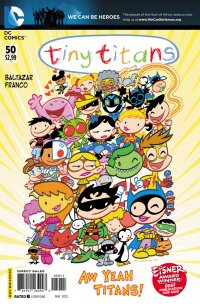
by Graig Kent
I’m not positive that Tiny Titans‘ cancellation makes it a late casualty of the DC Reboot, but it certainly feels like it. Though the company line is that the creative team of Art Baltazar and Franco are moving on to the new Superman Family title beginning in May, I’m left with the nagging suspicion that Tiny Titans is no more because it doesn’t fit in with the “new DC” image, what with all these miniature versions of Teen Titans past and present running around, looking nothing like their modern-day counterparts.
In fact Baltazar and Franco use this issue to touch upon the DC Reboot in the same winking, yet innocent manner in which this waaay out of continuity all-ages book regularly touched upon the past or immediate goings-on in the DCU proper. Here, with a ripped shirt from playing with Krypto in the Fortress of Solitude, Superboy get a new look from hologram Jor-El, and Supergirl does too, just for good measure (and why not Jor-El himself why he’s at it?), all of which bear an obvious resemblance to the New 52 designs. Later in the book the Titans encounter Superman mowing the fields of Kent farm, complete in t-shirt, jeans and workboots, where he advises an “S”-adorned pajama-and-cape-wearing Beast Boy, “I don’t think you need a reboot”.
There’s a little bit of reflection on the series as a whole, bringing Beast Boy’s long-standing crush on Terra to a head as the focal point of the issue, while also Peanuts-style reflecting on the kids’ superhero fantasies. In a surprisingly affecting moment, Robin and Cyborg pay Alfred a visit and get him to add Cyborg’s hamburger eating contest trophy (which he won in the Li’l Archie crossover mini-series) to the awards shelf, where it’s put up right beside two Eisners and a Harvey award (and above a picture of Balthazar and Franco together). They’re seemingly innocuous background details in the scene, but in reality so powerful, so touching and sweet, conveying just how much of themselves these two creators have put into this book, and how much it has given back to them. There’s no time for tears in Tiny Titans, as it’s all about fun and joy, but I still got a little misty from the impact of this two-page scene.
Too often comics aimed at younger readers really patronize or oversimplify. Tiny Titans didn’t do that. Balthazar and Franco created a unique world, sharing sensibilities with some of the most popular animated comedies or daily newspaper strips out there, the kind that appeal to kids, teens and adults in equal measure because they hit on all levels without compromising their voice for any single audience. Though it never knocked it into the stratosphere like Calvin and Hobbes or Spongebob, the strength of the creators’ vision in this book was of equal measure. It tickles the funny bone and triggers the “aww, cute” reflex as good as any comic that has ever existed, and like the best of the best, it adds something wonderful to pop culture that isn’t easily forgotten.
Aw Yeah, TItans, you’ll be missed.
Rating: 




Out of a Possible 5 Stars
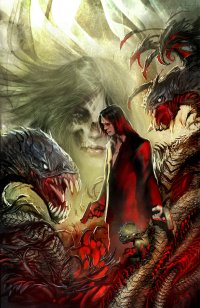 The Darkness #101 (Image/Top Cow, $2.99)
The Darkness #101 (Image/Top Cow, $2.99)
By D. S. Randlett
I think that the last Darkness comic I read was somewhere when the series was still in the early double digits. I remember liking the concept well enough, but the story at the time just really spun its wheels. Of course, this was a problem across the then-young Top Cow line. They were coming out with some pretty fun concepts like Witchblade, Ascension, and yes, The Darkness. It was a superhero universe that embraced things like Frank Frazetta album covers, horror, and noir along with some fun, if light, mythology. But over time, that proved to be all that they had.
But then, I must have missed something, because these books are still around.
This issue marks a reboot of sorts. Top Cow has had their characters in the midst of a big epic crossover for about a year. I was tempted to check it out, as I had heard some pretty good things about the web that Ron Marz, who can be really fun on his A-game, was weaving with this whole thing. Still, it was in full tilt by the time I had gotten back into comics just this past year, and coming to grips with that and DC’s New 52 initiative was kind of daunting. Thankfully, this issue opens with something of a recap of the big event, and a summary of the state of the TCU, written by Ron Marz and quite awesomely illustrated by John Tyler Christopher. This brief introduction actually makes me want to check out Marz’s work in this universe, as these five pages really get at some of the things at the center of The Darkness’ appeal.
Once inducted into the state of things, we’re thrown into a new story. Here we have a new creative team and, as the solicits boast, a new direction. New or returning readers won’t feel at all lost unless they have zero tolerance for stories that start in media res. Writer David Haun handles this entry with a deft sense of economy, quickly getting us familiar with who Jackie Estacado is, what his powers are (along with his relationship to them), and his world before plugging us into the story that he wants to tell. Jeremy Haun’s art is also rather good, eschewing Marc Silvestri’s style for a look more akin to Sean Philips’ work on Fatale or or Sean Martinborough’s work on Thief of Thieves. Haun’s work is a little less polished than Philips’ or Martinborough’s, but it fits this world and really brings out some of the dark fantasy and horror elements.
I was surprised by The Darkness this month. It feels like a book full of possibility. Fans of almost any genre will find something to like here: we touch on superheroes, crime, horror, and Michael Moorcock’s Elric stories. In fact, Estacado himself reminds me of Elric quite a bit, and The Darkness itself Stormbringer. Here’s hoping that, like Elric, Jackie Estacado will be able to swim in the soup of genres that his creators have placed him in and finally reach his potential. But the emphasis here is on possibility. This issue’s merits are many, but it’s not quite a homerun on its own. Still, it’s enough to bait the breath for further issues, and that’s quite something.
Rating: 




Out of a Possible 5 Stars
Dominique Laveau: Voodoo Child #1 (DC Comics, $2.99)
By Bart Bishop
I was stuck in New Orleans for almost two weeks. Well, stuck isn’t the right word, as it brings with it a negative connotation. Nevertheless, over spring break I traveled to New Orleans with my then girlfriend, now fiancée, to experience one of the best and worst trips of my life. Best because it’s an incredible, magical place with rich culture, music, and food; worst because our car broke down and needed a new transmission, stranding us at a Hampton Inn in the Garden District. What that did for me, however, is immerse me in the strange and wonderful world of N’awlins, giving me some insight into the area. With that in mind, I approached Dominique Laveau: Voodoo Child #1 with an eye on authenticity…
There are certain broad expectations that come with New Orleans. Jazz. “When The Saints Go Marching In”. The Ninth Ward. The Garden District. The French Quarter. Bourbon Street. Po’ Boys. Tulane University. Hurricane Katrina. Cemeteries. Oh yeah, and voodoo. It’s not that these are stereotypes, per se, as I can confirm first hand that they are important aspects of the spirit of the city. Superficial knowledge of these key characteristics can lead to abuses, however, as a writer may assume that New Orleans is only a hodge podge of those characteristics and nothing more, and any story set there will rely on those characteristics rather than crafting things like plot or character (re. X-Men’s Gambit, early ’90s). Hearing about this series, I was initially anxious that New Orleans would come across as a caricature.
According to solicitations, “DOMINIQUE LAVEAU: VOODOO CHILD is the story of a half-breed, outcast and heir to the Voodoo Queenship of New Orleans, if she can live long enough to claim her birthright. New Orleans is the most haunted city in America: a town of centuries-old ghosts and newly drowned spirits; where vampires, voodoo spirits and loups-garous make their home. Ruling over this all are the powerful Voodoo Queens, whose influence stretches into politics, business and crime as they maintain a delicate balance between the mortal and supernatural worlds.But in the aftermath of Katrina, all that has changed, for someone or something has murdered the Voodoo Queen and most of her court. The number one suspect is Dominique Laveau, a grad student at Tulane who is about to discover that her entire life has been a lie. Now Dominique must forge alliances with those out to kill her while seeking to uncover the truth behind the royal murders, as she is ultimately forced to deal with a destiny she could never have imagined. Voodoo Child is a new monthly series written by Selwyn Seyfu Hinds, former editor-in-chief of The Source magazine, award-winning author, journalist and TV producer, with art by Milestone Media co-founder Denys Cowan (THE QUESTION) and covers by Rafael Grampá.”
First of all, to understand the concept of this comic you have to be aware of Marie Laveau, the so-caled Voodoo Queen of New Orleans. She was a Creole, born free, in New Orleans that lived in the 18th and 19th centuries. After the death of her husband (under mysterious circumstances), she became a hairdresser that catered to rich white women. She claimed to be clairvoyant, but like my cemetery tour guide suggested, she might have just been a good listener to all the gossip in the city. She’s buried in St. Louis Cemetery #1 now, and her tomb is marked up with Xs and offerings, from people that hope to be granted wishes or good luck. This personifies humanity’s fascination with the superstitious: some people believe Voodoo to be an evil practice, like black magic, whereas some believe it to be a form of faith healing. That’s the dichotomy that informs the public perception, which has led to exaggeration and abuse in fiction.
I respect Selwyn Seyfu, as he has certainly captured the essence of New Orleans. The mood and atmosphere inherent in the narration is very engaging, as it has a conversational and colloquial aspect to it that’s welcoming and yet foreboding. It drops us in medias res and works as an anonymous (so far) insight into the world of the titular character Dominique Laveau. There’s a sense of jazzy improvisation with the stream of consciousness of the narration, but there is a structure with the repeated use of the “Jazzman” and “Great City” motifs, building upon and circling back to those concepts. Where the comic suffers, however, is in characterization. Dominique isn’t much more than a cypher at this point: she’s a Tulane student that volunteers with fellow students to help rebuild after Katrina; she has a policeman boyfriend with a thick Cajun accent; and she has mystical (as yet undefined) voodoo powers inherited from her ancestor. For this reason, she is being hunted by a mysterious man in black that carries a big gun and a big sword.
I haven’t read Selwyn Seyfu Hinds before, and this is apparently his first venture into comic books. It’s refreshing to see a person of color in the comic book industry writing a character of color, especially after all the controversy over The New 52’s struggle with diversity. Vertigo has been doing this for a while now, with an African lead in Unknown Soldier and a Native American Noir with Scalped. Still, I can’t help but feel that while he understands New Orleans and translates it to the page well, he doesn’t understand the language of comic books. The aforementioned well-realized narration reads like a prose novel, barely relating to the events that transpire on the pages. I understand what building mood is, but the narration suffers from telling-not-showing whereas the action barrels ahead without bothering to demonstrate how these characters live their lives.
The art by Denys Cowan is sketchy and surreal, but unfortunately lacks much weight. The opening pages of Dominique being chased by a giant werewolf-esque creature are jarring, as both seem to float off the ground with their paces. The creature, comparatively, has no sense of scale during its first appearance, as it could be as large as a city block for all I know. It also bothered me that Dominique herself, as rendered by Cowan, is basically a white woman with olive skin and darker hair. Comparatively, the cover by Rafael Grampá depicts Dominique as a woman that clearly possesses African-American features, being a creole of mixed race descent. I won’t compare this to the incident when Luke Cage and Jessica Jones’ baby looked 100% caucasian, but it’s disappointing that the two interpretations of Dominique (cover and inside) don’t match, especially since the cover is such a striking image. Grampá’s style is like a cleaner Frank Miller, and captures the themes inherent in the book perfectly. It also hints at a stronger Dominique than the character we’re initially introduced to, running for her life without asserting any control over the situation.
I wouldn’t be so critical, but the potential here is too great to be squandered. Dominique is a female lead, a person of color, and a graduate student (as opposed to a CW teenager): that’s a trinity of rare intrigue, and although I’m no fan of decompressed storytelling a little time could’ve been spent in this first issue to establish characters before setting them off running into random incidents and gore drenched room upon gore drenched room. This is one of four attempts in Vertigo’s initiative to establish a new face and persona. It’s an average start, but there’s possibilities here.
Rating: 




Out of a Possible 5 Stars
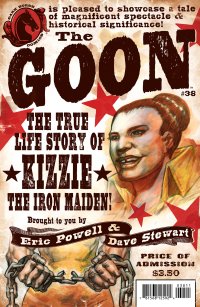 The Goon #38 (Dark Horse, $3.50)
The Goon #38 (Dark Horse, $3.50)
By Jeb D.
You expect an Eric Powell comic to go for certain reactions from the reader: the grossout, naturally, often of the “that’s so funny but so wrong!” type; the lightly creeped-out; the “fuck-yeah-hit-’em-again” response to the Goon’s fisticuffs; the bellylaugh; the appalled jaw-drop at Frankie’s latest antics… what you don’t generally expect Powell to go for is the lump in the throat, and while the latest issue of The Goon isn’t the first time he’s done it (notably in the Chinatown graphic novel), it’s far and away the most effective.
Powell has done a good job of world-building with the Goon, and expanding the cast, so that long delays between new comics, while frustrating, don’t leave the reader feeling lost: there are plenty of characters and stories in the Goon’s world that can hold our attention. Though regular readers will quickly understand the relationship of this story to the overall “Gooniverse,” new readers can simply take it at face value: Kizzie is a homely-looking young girl (and it says something about Powell’s abilities as an artist that he is able to convey a kind of offputting drabness to a woman’s looks in the context of an environment where just about everyone is more or less “ugly” by conventional standards). She grows up in the hardscrabble backwoods, endures the taunts of her peers, witnesses childhood horror, and develops the physical and mental strength to stand on her own. But the happiness that she thinks she has found bumps up against the parochial ignorance and complacency of her small town, and when she decides to chase a dream of greater horizons, the shitstorm begins.
The bulk of the adult Kizzie’s story takes place in the wonderfully-realized environment of a traveling carnival, of the sort familiar from our picture of Depression-era America. Through a series of bad, starry-eyed, choices, Kizzie becomes a circus strongwoman, takes up with a heel of a trapeze artist, and eventually finds herself alone, shunned by her family, and faced with the terrible choice of ending a pregnancy; when a face from her past returns, you skip past the conventionality of the device in your relief at the ray of hope brought to the life of this woman you’ve come to care about.
Yeah, this is not your usual two-fisted Goon story of zombies, satanic babies, and tommyguns. In fact, the Goon himself doesn’t actually show up until the book’s final page: the story we’ve been reading is his reminiscence of the life of the woman who raised him. But the simplicity of the storyline, and its use of some predictable beats, never feels cheap or compromised: Powell’s scripts are always of the show-not-tell variety, and the dialog is both rich in character and honed to the necessary.
But Powell’s gifts as a storyteller are principally visual, and while it’s easy to get lost in the lush aesthetic of his work (ably colored by Dave Stewart), his skill with sequential paneling, facial expression, cutting and editing, are sometimes taken for granted. It’s not always a compliment (or accurate) to say that a comic could be read pretty effectively without a single word balloon, but a wordless version of this comic, while it might be missing some expositional detail, would still hit every emotional beat. There’s an extremely effective sequence with the young Kizzie watching a frightening, unexpected death, but it’s no more gripping than the single panel of her sagging in miserable despair in the abortionist’s office. If I have one reservation, it’s that the jump-cut to the Goon’s valedictory is a little abrupt.
Powell prefaces the story with a dedication to “the best grandma anyone could ask for,” and from the pictures, his late gran appears to have been a Wanda Jackson/Patsy Cline type guitar-slingin’ gal, and while Kizzie doesn’t appear to resemble her much, Powell brings the love for both women alive on the page.
Rating: 




Out of a Possible 5 Stars
Stan Lee’s Mighty Seven #1 (Stan Lee Comics, $2.99)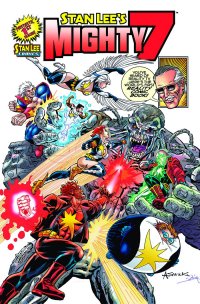
By Adam Prosser
“I’m Stan Lee! But don’t hold that against me!” –The actual opening panels of Mighty Seven
At this point I’m tempted to say that no 20th century creative figure has managed his image better than Stan Lee. Not just in comics, in any medium. Not David Bowie. Not Andy Warhol. Not Tom Hanks or Salvador Dali or Lady Gaga or Marilyn Monroe or Cary Grant. My vote is for Stan the Man as the #1 self-promoter of the last hundred years. It is, after all, what he does, far more than writing or editing or publishing. The genius of Stan’s work at Marvel was that he was able to assemble a team of creatives who were actually producing work worthy of being hyped to high heaven, and then he reinvented the concept of hype to do so. It was a masterstroke—with Stan’s typically bombastic style, he was able to indulge his ego while still maintaining an ironic distance that kept him likeable and approachable—and that approachability led to a great rapport with the fans, who when gleefully bought into the hype, and the cycle continued. Even today, it’s impossible to read Stan’s carnival-barker prose, on the covers, in promotional art and columns, within the comic itself—and has any product ever advertised itself as shamelessly as a mid-60s Marvel comic?—and not somehow buy into the idea that, yes, I DO have to buy this without asking, this may in fact be the most sensational event of all time, I can’t miss the next issue!
Of course, even the most brilliant promotion isn’t going to hold up forever if the stuff being hyped isn’t worth reading, so of course this is where folks like Kirby and Ditko came in—the artists who, armed with a smattering of legitimately good ideas from ol’ Stan, actually made the comics that were enthralling the nation throughout the 60s. Even by Stan’s ever-shifting accounts of the era, the actual storytelling was something he at best contributed to, usually with his distinctive dialogue polishes, rather than something he can lay claim to single-handedly. The best thing Stan Lee ever wrote by himself was his letter columns. Which I don’t mean as a snark (well, OK, I do, but they really are excellent letter columns), but the point is that once Lee parted ways from the Merry Marvel Marching Society, he suddenly found himself in the unenviable position of being the sole creative guiding light on a number of projects in the 90s and 00s. All the hype in the world couldn’t save Stripperella or that Backstreet Boys comic.
And yet, such a brilliant job did Stan Lee do of selling Stan Lee in the 60s, that he’s still being asked to bring his supposedly magic touch to new comics projects, and thus we get Stan Lee’s Mighty Seven, from Stan Lee comics (a newly-founded division of Archie), retailing for 2 Stan Lee dollars and 99 Stan Lee cents at a Stan Lee comics retailer near you. Stan Lee Stan Lee Stan Lee.
What’s Stan Lee’s Mighty Seven about? As you will no doubt be shocked to learn, it’s about Stan Lee. Seriously, the lead character is Stan Lee, who we find in a surprisingly melancholy mood as he approaches the editors of THIS VERY COMIC BOOK and pitches them a new idea, one no doubt too radically outrageous for us, the audience, to process. Fortunately, Stan spares our fragile grey matter by not actually telling us what this idea is, and editor Jon Goldwater encourages him instead to come up with…more superheroes. Stan, uncharacteristically humble, suggests that he “doesn’t have another superhero in him”, but fate quickly intervenes when a downed spaceship full of intergalactic superheroes—well, two heroes and a cargo full of morally ambiguous super-prisoners—crashes nearby, providing, presumably, the inspiration Stan was looking for. Stan even magnanimously devotes many pages of the comic to these cosmic renegades and their adventures before arriving on Earth (home of Stan Lee).
Of course, you don’t actually hire Stan Lee to WRITE your comics, and thus the actual script is by Tony Blake and Paul Jackson (“with Stan Lee”, from a concept by Stan Lee), with charmingly retrograde artwork by Alex Saviuk and Bob Smith. Actually, “charmingly retrograde” describes the comic as a whole; even in the 60s, there was something amusing about this middle-aged guy (Stan Lee) ingratiating himself on the cutting edge of the new youth movement, and needless to say whatever hipness Stan once possessed has long since dissipated. To this comics’ enormous credit, it makes very little attempt to pretend that it’s in any way “cool”, and even its token gestures in that regard (the design of rogue vigilante Blastok features a leather jacket and pimp shades, like your grandpa trying to draw an early-90s Image character) are so dorky they become charming.
Oh, is the comic any good, you ask? Well, wayfarer, it’s the most awesomely-adequate avalanche of mere mediocrity the mortal mind can manage! A simplistic superhero spectacular stuffed with samey shenanigans! Yet only a churl would chuff at its cheesy charm!
Not that any of this really matters, does it? It’s Stan Lee’s world now. You and me? We just live in it.
RATING: STAN LEE OUT OF FIVE
Hoax Hunters #0 (Image, $2.99)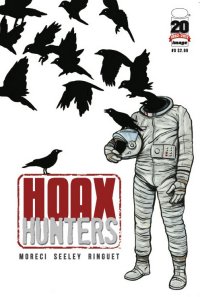
by Graig Kent
The “reality TV” comic is becoming almost as played out as reality TV itself, but if the central idea for the comic is strong enough and the execution uniquely engaging, just like any reality TV show, it will find its niche and succeed. I’m not sure Hoax Hunters has either.
Here we have an attempt to merge the paranormal investigator reality show with the paranormal conspiracy comic (think Ghost Hunters meets Planetary or Fact or Faked: Paranormal Files meets BPRD) but with a twist! The “Hoax Hunters” are using their show to discredit actual metaphysical phenomena, and behind the scenes, they have their own supernatural abilities, along with some sort of worldwide, illuminati-like clout backing them up. With such a set-up the results are pretty much exactly as expected, which is a shame because, for a comic steeped so deeply in the unknown, it should be far more unconventional.
Writers Michael Moreci and Steve Seeley nail the lameness of the paranormal investigating television show and the fakeness of the discourse in the scant few moments they actually use of their reality TV conceit, but unfortunately the book’s main characters never rise above that same level of generic personalities. In debunking the youtube-proliferating video of a hovering, crow-infested NASA spacesuit before the camera, the Hoax Hunters team is in actuality pursuing the mystery of what – or who – it is, and the process of doing so leads to a less-than-enthralling explanation and a ho-hum altercation that is more confusing than it is exciting. There’s an opportunity to manipulate the reality TV genre in clever and interesting ways when shifting them to a new medium (see Jeb’s write-up of Supurbia two weeks ago for one way it can be done well) but the writers don’t seem all that interested in doing so.
Moreci and Seeley’s script isn’t the tightest or cleanest, as it occasionally required a few panel rereads to be clear on what was being said, or what was happening in the scene. Some of the blame in this regard falls upon artist JM Ringuet who fails to always deliver easy-to-follow visuals. His thick lines make finer details an impossibility, and his figures are quite rigid and frequently inconsistent, with muddy coloring not helping the situation (though I bet they would appear a lot better in a digital comic, as it seems altogether washed out on paper, the heavy black ink less than crisp). There’s unfortunatley little of the charm here that Ringuet displayed in Jonathan Hickman’s Transhuman (though he does have a way with animals).
It’s a shame that what’s beneath Seeley’s strikingly designed cover is something that isn’t nearly as appealing or impressive.
Rating: 




Out of a Possible 5 Stars
Ragemoor #1 (Dark Horse, $3.50)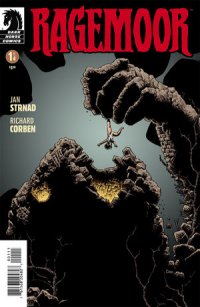
By D. S. Randlett
If anything has art by Richard Corben, my advice is usually simple: buy the damn thing already.
I really loved the last book by Corben that Dark Horse put out, Murky World, but it was a bit hard to recommend. In terms of story, it was very loose, and seemed mostly to serve as a dreamlike space for Corben’s experimentation. Ragemoor, which reteams Corben with his longtime writing partner Jan Strnad, is quite a bit more accessible, even if it might seem a bit more typical than Murky World.
The story of Ragemoor is very much in the Lovecraft/Poe mold: A sentient castle has built itself up over the centuries, first brought to life by thousands of Pagan sacrifices. Ragemoor thirsts, and it will drink. In the grip of Ragemoor’s curse is Herbert, a young man who appears to be the heir of Ragemoor, but who owns who here? His relationship to the house is still a mystery: why hasn’t Ragemoor taken him, his butler, or his insane father? There’s a lot of mystery lurking in these pages, but none of it feels cheap. Instead of playing motivations close to the vest for the sake of a cheap revelation, Strnad’s story presents the reader with clear conflicts and character motivations, with enough questions to build the story’s momentum leading into this first issue’s bizarre climax.
For Corben’s part, there are no surprises here. His work is as great as it’s ever been, except the bleakness and emptiness of Murky World have been replaced with a rich sense of gothic detail. His work here, and the book in general, has a similar effect to the recent Prometheus trailers: sinewy, spooky, and fun.
In summation, buy the damn thing already.
Rating: 




Out of a Possible 5 Stars
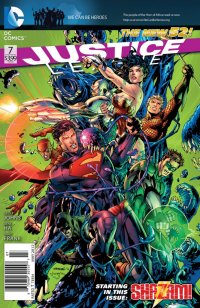 Justice League #7 (DC Comics, $3.99)
Justice League #7 (DC Comics, $3.99)
by Graig Kent
I have a love-hate relationship with Geoff Johns that is so tumultuous that it can shift from one to the other three or four times within the same book, sometimes on the same page. Take Justice League #7 for example…
LOVE: page 3. The simplicity with which Johns introduces Steve Trevor of A.R.G.U.S. as “the world’s liaison to the Justice League” in the throes of a fierce battled against little toothy-demons.
HATE: page 3. the ham-fisted, b-movie style audience reaction to the Justice League’s arrival “It’s THEM!” “THANK GOD!” “We’re going to be okay! Everything’s going to be okay!”
LOVE: page 3. Steve Trevor’s reaction to their arrival (but that’s to artist Gene Ha’s credit, selling that look)
LOVE and HATE: page 6. The overly thorough exposition which at the same time makes sense since Cyborg is completely piped into pretty much any network or camera feed, and yet it’s such a drag to read (especially as it continues over through the next page).
HATE: page 6. Johns’ gag humour, “I don’t need an umbrella” says Aquaman to Green Lantern in the rain. Groan.
HATE: pages 6-8, 12. Green Lantern as a philandering, annoying, impulsive jerk. In other words, Wally West circa 1987. But doesn’t seem like the appropriate voice for Hal Jordan.
LOVE: page 8. Batman’s reaction to Green Lantern being an annoying, impulsive jerk (again, much of the credit going to Gene Ha’s selling of the scene)
LOVE: page 9. the Hal and Barry interaction is actually sharply written and funny.
HATE: page 9-12. The entire Justice League taking on, essentially, a domestic disturbance. Cyborg could have handled this solo. It’s beneath them as a collective despite the threat level Cyborg exposited earlier.
LOVE: page 13. Steve Trevor. Johns has this guy’s pulse.
HATE: page 13. Everything else on this page. “Who don’t [the Justice League] do… the government’s job,” one reporter asks in press conference in a way no reporter who isn’t working for a junior high-school student newspaper would ask. And then the rest of the crowd starts chiming in: “They give us hope!” “They’re not at each other’s throats. They’re friends.” “They’re Super-Friends!” Another groan-inducing wink-nudge from your pal Geoff. (And is it supposed to seem lik “How’s Your News?” is questioning him?).
LOVE: page 14. Steve Trevor is a badass. “This suit is MY costume. It only makes me look civilized.” That’s a great line.
HATE: page 15/16. This whole congressional meeting was like something out of an Adam Sandler flick, cartoony and cliched.
LOVE: page 18-21. Steve Trevor’s reactions (again a Gene Ha specialty). Batman’s assessment of the JLI. A nice moment showing why, exactly, Steve Trevor would be in love with Wonder Woman, and why he does what he does.
HATE: page 18-20. The Big Bang Theory-level of bickering going on in the background. I get it, “They’re not at each other’s throats.” Oh yes they are. “They’re Super-Friends!” Oh no they’re not. #sadtrombone
I’m not a fan of Geoff Johns’ stabs at situational comedy (it’s why I stopped reading Aquaman) and he’s got absolutely no ear for political banter. The real world isn’t his bailiwick. He tends to shine dealing with emotions (it’s no wonder his Emotional Spectrum Lantern Rings were such a hit) as he does here with Steve Trevor. As well, he’s good at dealing with fictional realities, hierarchies and constructs, where the real world doesn’t apply.
There’s another example in the back-up feature which reintroduces Captain Marv… ahem… Shazam to the DCU, Johns introduces us to Billy Batson as he interviews a prospective family in an orphanage which comes across, again, as fakey and cliche. The scene he relays is of an “aw shucks, gee whiz” kid impressing the pants off potential foster parents, and they completely buy into it. Johns plays into every “poor orphan kid” convention, but subverts it with the big revelation that BIlly Batson is really a dickhead, a troubled, mean spirited kid too clever for his own good. This revelation puts the previous scene into a whole different context as a fake-out, and yet, it doesn’t work if the foster parents buy into it. If it’s phony to the reader it should either come across as phony to the foster parents, otherwise it should be sold as genuine earnestness. Johns is trying to have his cake and eat it too.
I won’t go in too deep about how I feel about dropping the Captain Marvel moniker for Shazam, lest to say I’m a bit of a purist and I don’t like it, nor do I like some of the changes to his power set (lightning hands?) that have been proposed but aren’t yet seen here (save for a splash page teasing what’s coming up). There are more than a few boys-who-turn-into-men superheroes out there but Captain Marvel is the original and he’s a powerful figure especially for young readers. That he’s continually being toyed with, diverging further and further from where he began may seem like progress but only serves to dilute the impact of the character. There’s a lot of super-strong characters out there, but there’s so many lightning and electricity based ones too that it seems an unnecessary exchange. Captain Marvel was always a great counterpoint to Superman, not despite their similarities but because of them, with the juxtaposition of Fawcett City and Metropolis, the Marvel Family and the Superman Family, Sivana and Lex Luthor and their respective rogues galleries strongly differentiating them in style and substance. Here, you’d be hard pressed to tell Sivana apart from Lex Luthor. While Gary Frank does a great job bringing the characters into a natural looking world (they’re good looking pages), the result is Shazam now looks like just another comic book character.
But for all I hate, there are some things that Johns does here that I like. The shift in the myth of the wizard is a nice twist, as he abducts person after person looking for the next inheritor of the power of Shazam. Sivana (tall, bald, buff and decidedly Luthor-ian) is documenting all these abductions and trying to dig out the truth was also a nice introduction to his character (although they blow his wad too soon by giving him both the answer already and malevolent eyes that show the reader he’s up to no good).
This issue is in equal measure the good and the bad that Geoff Johns has to offer. Being the premiere book in DC’s line now, it’s not nearly as good as it should be, in my opinion, and so It’s not something I would recommend, but it’s also not so offensive that I would advise you not to read it either.
Rating: 




Out of a Possible 5 Stars
Supercrooks #1 (Icon, $2.99)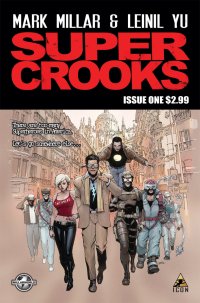
By Jeb D.
“I’ve never heard of a Captain Spain–have you?” Pose that question to you or me and we’d probably envision some Iberian variant on Batroc, with an accent borrowed from Fawlty Towers‘ Manuel.
But that’s why you and I aren’t rich comic book writers, and Mark Millar is. He took that simple question and built it into his latest creator-owned-movie-premise-with-superstar-artist-money-spinning-machine.
For all that I can be amused by Millar the hype merchant, I do get frustrated at the way his natural storytelling gifts too often get shoved aside for the grab at publicity, the in-jokiness, and the sensationalism of violence. And in a refreshing change of pace, the first issue of Supercrooks is relatively free of either fanboy pandering, or mainstream shock value. In fact, this is probably the most mundane, conventional Millar comic I’ve read in some time… for better or worse.
The premise (from Millar, Lenil Francis Yu, and “co-plotter” Nacho Vigalondo) is plastered all over the cover and all the ads: a loose confederation of costumed criminals is continually running afoul of the virtual army of superheroes protecting their city, and they’re beginning to give up on the whole idea of super-crime. Our protagonist, Johnny Bolt, fresh out of prison, is the last refuge of one of his old comrades that owes millions to the (super-criminal) Mob. How to get the money with all the super-vigilance going on? Recruit some old pals, and head for greener pastures: Spain (so far as Johnny knows) has no superheroes, and is the ideal place for the score that will save his old friend’s life. Naturally, that’s just the excuse: Johnny’s in love with the life, even if his onetime fiancée and villainess-turned-waitress Kasey wants him to leave it behind and settle down. But hey, costumes or no, this is a crime story, and the last panel of this issue is exactly what you’d expect it to be: Johnny sets off “to get the old band back together.”
And that’s about it, really: a familiar setup, handled briskly, with every beat comfortably telegraphed; whether as the opening issue of a comic series, or the first fifteen minutes of Millar’s next film, it’s the kind of clichéd introduction that works precisely because it satisfies our expectation: what makes or breaks the story, of course, is what variations Millar runs on the story in the issues to come.
There’s a spot or two of violence, but nothing on the Nemesis or Kick-Ass order. Yu (with inker Gerry Alanguilan and colorist Sunny Cho) takes good advantage of the few action beats, but the character work is what’s most impressive: it’s among the best and cleanest I’ve seen from him, with a feeling of relaxation away from the deadline pressure of a monthly or “event” title.
Not a bad start to a story, though the events of this issue will be easily summed up on the recap page of issue #2, which is where we’ll find out just what Millar’s got to offer on this one. So feel free to wait.
Rating: 




Out of a Possible 5 Stars